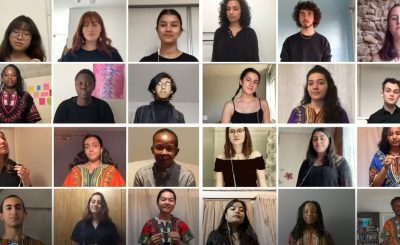This reflection was originally written for the Winter 2016 issue of Kaleidoscope. Tandiwe recently recorded a virtual version of Shosholoza with members of the 2020 African Chorus.
This past August, at the insistence of my fellow reunion classmates from 1989 and 1990, I took to the stage to lead the Blue Moon Cafe audience in singing Shosholoza. This was already an unusual format for the Blue Moon Cafe because typically the audience is entertained by the performer and not asked to be part of the performance. When asked to do this, I initially declined for several reasons, least of which was that I had not sung in that kind of forum since the early 1990s and so much time had elapsed since I last sang Shosholoza. Eventually, I was encouraged sufficiently, and in my introduction, I spoke about arriving at UWC-USA in 1988 and how I relied on the power of song to integrate into my new community.
Until I arrived at UWC-USA, I was immersed in a community characterized by struggle, defiance, and the quest for freedom. My parents went into exile for the second or third time shortly before my birth, so exile was the only life I knew. Song was an important source of inspiration during the struggle, and I learned to draw courage and strength from the songs we sang.
I remember first introducing the song Shosholoza to my classmates. It was during orientation at Philmont Scout Camp in Northern New Mexico, and as was customary for the final evening, each national group performed a piece. As we planned for the evening, I suggested a song—and particularly one that focused attention on the untenable plight of South Africa under the rule of apartheid. We practiced the song as we hiked in the mountains, so that by the time we performed it, we had developed a familiarity with the words and melody.
The song Shosholoza originates from the mines of South Africa. Rich in mineral resources, mining in South Africa was an economic pillar on which apartheid thrived. It was able to do so because black laborers—cheaply imported from nonurban centers—worked in the mines for low wages under substandard conditions. Miners were often separated from their families for extended periods. The song is about the train that comes from a particular destination—stimela esi puma e South Africa—the train that originates from South Africa.
So what did it mean to us to sing Shosholoza in 1987 and then 27 years later in 2015? Most important, as I started the song, I slipped into a familiar feeling of empowerment and being part of a larger purpose and community. The simple call and response construct of the song, along with the power of the lyrics and harmony, empowered us then and now by evoking a true sense of harmony, unity, and common aspiration for the betterment of our respective societies. The experience was inspiring and comforting. I was amazed that the younger classes after my class joined in to sing with a familiarity that suggests the song was passed on from year to year at UWC-USA. In that moment, Shosholoza united us across generations.

